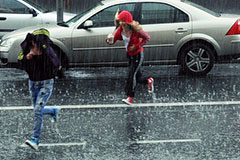Driving Safely in Extreme Weather Conditions - Vol.326
Sudden violent weather conditions are common in many areas and when they strike, safely maneuvering through a windswept road with low visibility can be very dangerous. While rain and wind are not usually a serious concern for most experienced drivers, the surprisingly difficult conditions they present can test the responsiveness of drivers of all skills.

Avoidance First
Most often this dangerous situation can be avoided with a little foresight and commitment to never attempting anything dangerous behind the wheel of a car. Even professionals who drive vehicles for a career caution motorists against taking chances by driving in extreme weather conditions.
Choosing to drive in poor weather is not just a danger to your own safety but to the safety of any other motorists or anyone that may be on the road or in the back of your car. If the grave danger of driving in extreme weather conditions has been established, it is apparent that full concentration and focus will be needed to arrive at a destination unscathed and without causing any accidents on the way.
Driving in a Strong Winds and Rain
While the wind may seem a minor risk, it drastically affects the dynamics of driving, especially for those driving larger vehicles. High winds are not common in urban driving, but wide open spaces and mountainous roads can present serious wind speed issues. There are also highway overpasses, tunnel exits, road sections and geographic features that can act as a wind funnel and greatly affect the cars movement.
Rain carries the risk of losing control of the vehicle as it slips on a slick surface, especially dangerous in those first few minutes of rainfall. With reduced visibility added to the equation, driving in the rain increases the possibility of a serious accident. Following are some important points to keep in mind if the weather looks bad:
Anticipate - keep an eye on the wind and weather outside your vehicle and be aware when you enter areas that are prone to high winds and always stay aware of the weather reports in your area. Knowing the forecast is especially important when driving to areas you are not familiar with.
Stay Clear - the wind or wet roads can cause a vehicle to lose control, even momentarily. Cars that are driving too close to each other can collide easily. Keeping a safe distance from other vehicles, especially very large vehicles, is the best way to avoid an accident.
Slow Down - Hydroplaning happens when a car's front wheels are sliding on a skin of water and the handling of the vehicle has been greatly compromised. Avoid this by driving slowly. The slick roads or high wind speeds have a greater effect over cars moving at high speeds. Taking those few extra minutes to arrive at your destination could basically save your life.
Turn on the Lights - as visibility is reduced, even slightly, turning on your hazards light alerts other motorists to your presence on the road. Your vision may be perfectly clear, but you will not be driving the truck that collides into your vehicle. Play it safe and stay visible.
Final Notes on Driving in extreme Conditions - as mentioned before, choosing to wait the few extra minutes or hours so the weather clears can be a matter of life and death. Nevertheless, if circumstance has placed you on the road in a wind and/or rain storm, the first thing to do will be to lower the music and put away any mobile devices. This will allow you to detect incoming and upcoming obstacles and be more attuned to the vehicle's position on the road.
Never take chances and drive safely.